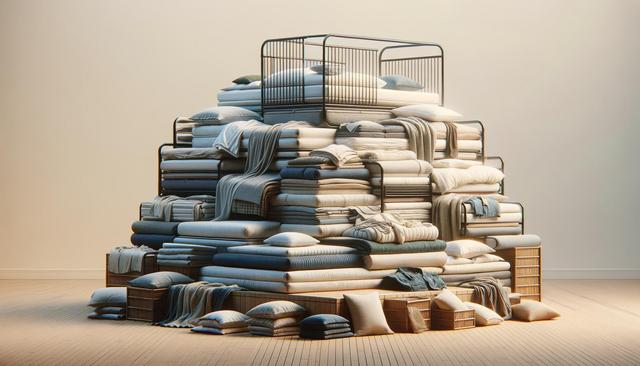Maximizing Small Spaces with Folding Beds
In today’s compact homes and apartments, making the most of limited space is more important than ever. Folding beds present an efficient way to accommodate guests or create extra sleeping areas without permanently sacrificing valuable floor space. Whether you live in a studio apartment, a shared space, or simply want to optimize a guest room, a folding bed can provide the flexibility you need. These beds are designed to be stored easily—against a wall, inside a closet, or even under another piece of furniture—making them ideal for multipurpose rooms.
One of the key advantages of folding beds is their portability. Many models come with built-in wheels, lightweight frames, and simple folding mechanisms, making setup and storage quick and hassle-free. This can be particularly useful for individuals who frequently host visitors or need a temporary sleeping arrangement for children’s sleepovers or home offices doubling as guest rooms.
Common placement options for folding beds include:
- Closets or wardrobes with sufficient vertical clearance
- Under traditional beds or sofas
- Wall-mounted units that blend with the decor
- Garage or attic storage for occasional use
For anyone navigating a tight layout, folding beds can be a smart and functional addition that enhances space efficiency without compromising comfort.
Types of Folding Beds and Their Features
Folding beds come in various designs to suit different user needs and aesthetic preferences. The most common types include rollaway beds, Murphy beds, and tri-fold foam mattresses. Each type has distinct features that cater to different space and mobility requirements.
Rollaway beds are among the most portable, typically folding in half and rolling on casters. They often feature a metal frame and a medium-thickness mattress, making them a solid choice for temporary or guest use. Murphy beds, on the other hand, are built into cabinets or wall units and fold vertically against the wall. These are more permanent solutions that integrate seamlessly into décor, often doubling as bookshelves or desks when closed.
Tri-fold foam mattresses offer the most flexibility in terms of portability. These can be folded into compact sizes for storage and are lightweight enough to be carried easily. They’re especially useful for camping, road trips, or casual lounging at home.
Key features to consider when choosing a folding bed include:
- Bed size (twin, full, queen)
- Frame material and durability
- Mattress type and thickness
- Ease of folding and mobility
- Storage dimensions
Understanding these types and features can help you select a folding bed that fits seamlessly into your lifestyle.
Comfort and Support Considerations
While folding beds are often associated with temporary use, advancements in design and materials have significantly improved their comfort levels. Today’s folding beds can offer a sleeping experience comparable to that of standard beds, provided the right model is chosen. The mattress is a critical component, and options range from memory foam to innerspring and hybrid types.
Supportive frames also play a significant role in enhancing comfort. A sturdy frame helps maintain mattress integrity and distributes weight evenly, reducing pressure points. Some high-quality folding beds include slatted bases or reinforced steel structures that improve durability and support.
For those planning to use a folding bed more frequently, it might be worth investing in models with upgraded mattresses and ergonomic frames. Additionally, adding mattress toppers or using fitted sheets can further enhance the sleeping experience.
Comfort-enhancing tips include:
- Using a mattress topper for added cushioning
- Placing the bed on a flat, stable surface
- Ensuring proper ventilation for foam mattresses
- Storing the bed in a dry, clean area to maintain hygiene
By paying attention to these comfort and support factors, you can ensure that your folding bed offers restful sleep, even for longer durations.
Practical Uses Beyond Guest Accommodation
While folding beds are widely known for guest accommodation, their applications extend far beyond that. These versatile pieces of furniture can serve multiple roles in various settings, from travel to daily use in compact living areas. Their fold-away nature makes them suitable for people who value minimalism or need to adapt their space for different activities throughout the day.
In addition to home use, folding beds are commonly utilized in:
- Vacation homes and cabins with limited space
- Temporary housing or rental units
- Hostels and dormitories
- Mobile homes or RVs
- Emergency shelters or disaster relief housing
Families with young children may find folding beds useful for sleepovers or nap time, while digital nomads and remote workers might use them to furnish flexible living arrangements. In urban areas where space comes at a premium, incorporating folding beds into multifunctional rooms can create a more dynamic and efficient home environment.
Professionals in the hospitality industry also appreciate folding beds as they allow for quick and easy accommodation adjustments. With their practical nature and growing design options, folding beds continue to expand their role beyond short-term convenience.
Maintenance and Storage Tips
Proper maintenance and storage can significantly extend the life of your folding bed. Given that many are used intermittently, keeping them in good condition between uses ensures they remain comfortable and functional when needed. Start by cleaning the mattress and frame regularly, especially after use. Vacuuming the mattress and wiping down the frame with a damp cloth helps remove dust and allergens.
When storing a folding bed, make sure it is completely dry to prevent mold or mildew. Choose a cool, dry location—such as a closet, under a bed, or in a storage room—to avoid exposure to moisture or extreme temperatures. Using a storage cover can also protect against dirt and pests.
Additional storage tips include:
- Folding the bed properly according to the manufacturer’s instructions
- Securing the frame with straps or locks to prevent accidental unfolding
- Keeping it upright or flat, depending on the design
- Regularly checking for wear and tear on the wheels or hinges
Routine checks and simple care routines can help your folding bed remain a reliable and hygienic option for many years to come.
Conclusion: A Practical Addition to Any Living Space
Folding beds offer a smart and adaptable solution for anyone looking to enhance their living space without permanent changes. Whether you’re in a compact apartment, frequently host guests, or need a versatile sleeping option, folding beds provide comfort, convenience, and functionality in one package. With a wide range of types and features available, it’s possible to find a model that fits both your space and your specific needs. By considering factors such as comfort, storage, and usage frequency, you can make an informed decision that adds value to your home over the long term.


